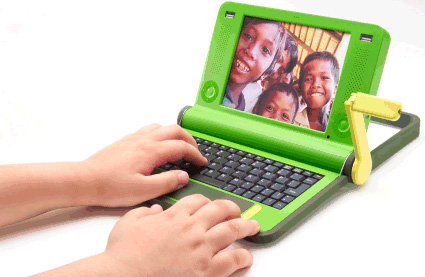Werner
Object From The Future
===The 100 Dollar Laptop=== / IN PROGRESS
The $100 laptop is an ultra-low-cost, full-featured computer designed to dramatically enhance children's primary and secondary education worldwide. It is the central project of the nonprofit One Laptop per Child (OLPC) association, which aims to equip the world's schoolchildren and their teachers with a personal, portable, connected computer.

The project was proposed in January 2005 at the World Economic Forum in Davos, Switserland by Nicholas Negroponte, co-founder of MIT Media Lab. The idea is that governments pay roughly $100 for the laptops and distribute them for free to students in the lesser developed nations. The idea was very popular and in the months after the Forum, Negroponte and his nonprofit association devoted time and effort into getting the neccesary parties on-board in order to create a prototype. U.N. Secretary-General Kofi Annan unveiled the first working prototype of the $100 laptop November 16th at the World Summit on the Information Society in Tunis.
The device can be recharged with the wind-up arm, the laptop's design enable users to use the laptop over 40 minutes after one minute of winding the battery.
Replace
Why would children in developing nations benefit from using laptops in school ? For one, there is the informational benefit; children can access a wealth of knowledge online. OLPC makes a comparison to a community pencils as opposed to community internet-access centers; 'They are tools to think with, sufficiently inexpensive to be used for work and play, drawing writing and mathematics. A computer can be the same but far more powerfull. The problem of connectivity is currently being investigated. According to OLPC, a lot of organizations are interested in aiding in financing internet connections in developing nations. The first and foremost means of connectivity at the moment is the mesh network these laptops can make with eachother.
Change
According to Nicholas Negroponte, 'Children are the greatest natural resource of any country, and educating these children is at the root of solving our largest and most complex problems.' Nicholas continues, 'Yet the best education may not come from sitting in a traditional classroom, but rather through independent interaction and exploration. The development of a $100 laptop will now make this possible for all kids -- especially those in developing nations. It will redefine how we 'learn learning.' ' The tactic that OLPC is going to use is that of a grassroots movement. The software that is being used is all Open Source, OLPC aimes for a mass movement in line with Linux and Wikipedia.
Growth
At the moment, a few prototypes have been created for press and negotiation purposes. Five companies are working with MIT to develop an initial 5 million to 15 million test units within the year. These companies are Google, Advanced Micro Devices, News Corp., Red Hat and BrightStar. The current plan is to produce 100 million to 150 million units by 2007.
While the initial goal of the project is to work with governments, MIT is considering licensing the design or giving it to a third-party company to build commercial versions of the PC. Those might be available for $200, and about $30 will come back to OLPC to make the kids' laptops. This is still in consideration.
Initiative of Nicholas Negroponte, co-founder of MIT Media Lab in collaboration with the UN Targeted production; 150 milion per year Thailand, China and India have expressed their interest
The proposed design of the machines calls for a 500MHz processor, 1GB of memory and an innovative dual-mode display that can be used in full-color mode, or in a black-and-white sunlight-readable mode. The display makes the laptop "both an electronic book and a laptop," he said.
Power for the new systems will be provided through either conventional electric current, batteries or by a windup crank attached to the side of the notebooks, since many countries targeted by the plan do not have power in remote areas, Negroponte said.
The machines, which will run a version of the Linux operating system, will also include other applications, some developed by MIT researchers, as well as country-specific software. "Software has gotten too fat and unreliable, so we started with Linux," he said.
For connectivity, the systems will be Wi-Fi- and cell phone-enabled, and will include four USB ports, along with built-in "mesh networking," a peer-to-peer concept that allows machines to share a single Internet connection.
"In emerging nations, the issue is not connectivity," Negroponte said. "That was the issue, but there are many people working on it, (thanks to) global competitiveness. But for education, the roadblock is the laptop."
References
Werner Heijstek
March 19th, 2006